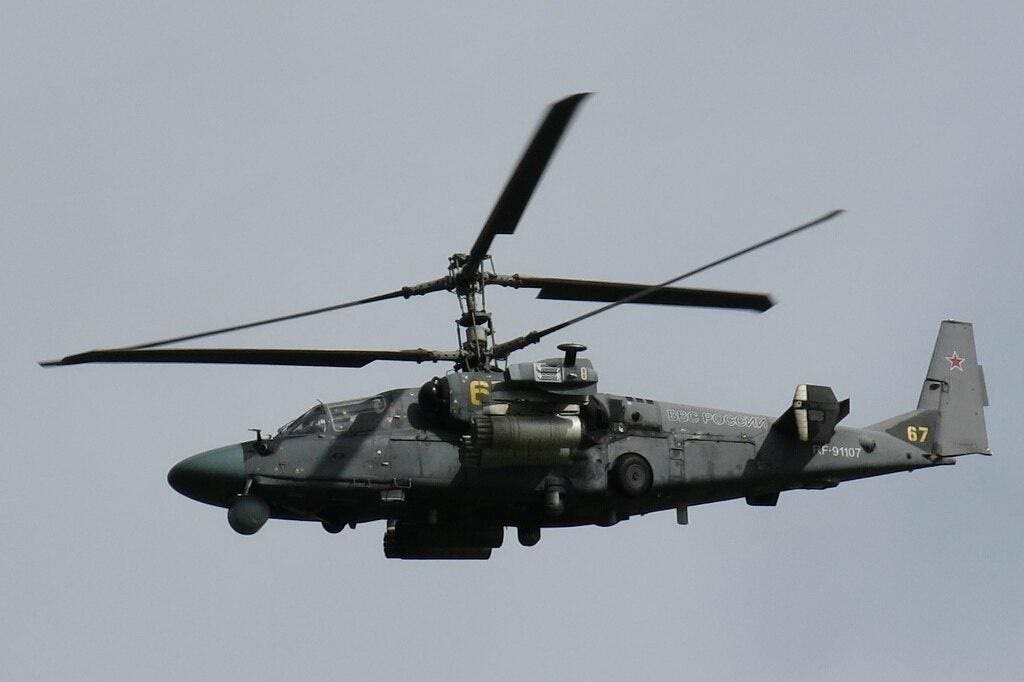The Ukrainians may have found another way to shoot down the Russians’ attack helicopters.
A video that circulated online on Wednesday depicts a Ukrainian first-person-view racing drone, presumably laden with explosives, apparently trying to intercept a Russian air force Kamov Ka-52 attack helicopter—and nearly succeeding.
The speedy little quadcopter tails the Kamov until the helicopter’s two-person crew seems to notice the drone—and darts away. A two-pound, $3,000 DJI Mavic 3 FPV drone has a top speed of just 40 miles per hour. A 12-ton, $10-million Ka-52 can fly as fast as 200 miles per hour.
But a Ka-52 crew can’t always rely on its speed to save it. The helicopter’s best weapon is the 90-pound Vikhr anti-tank guided missile, which is a so-called “beam-rider.” To use a Vikhr, a Ka-52 crew must hover a few hundred feet off the ground, shoot a laser beam at the target from as far as six miles away then fire the missile—which follows the laser all the way to the target.
The problem is, the firing helicopter can’t move until the missile hits. And that can take tens of seconds—an eternity when Ukrainian air-defenses are nearby. It’s not for no reason that the Russians have lost no fewer than 41 Ka-52s, and many of their most experienced crews, in 19 months of bitter fighting in Ukraine.
Ukraine’s new Swedish-made RBS-70 shoulder-fired, laser-guided anti-aircraft missiles already were vexing Russia’s Kamov crews when the FPV threat first loomed.
A Ka-52 has countermeasures against laser-guided missiles. But the countermeasures don’t always work—especially against an RBS-70. The 190-pound, two-person air-defense system fires a supersonic missile as far as 5.5 miles. Nearly as far as a Vikhr ranges.
While its primary guidance is a laser, the RBS-70 works even when the laser gets spoofed. “The operator on the ground can use manual control at any time after launch and thus change the target point,” explained Saab, the missile’s manufacturer.
The RBS-70’s backup guidance helped crews from the Ukrainian army’s 47th Mechanized Brigade shoot down two Ka-52s in a 24-hour period on Aug. 17. It was sweet revenge for the brigade, which has been on the receiving end of countless Vikhr missiles since the unit joined Ukraine’s southern counteroffensive starting in early June.
Now the hovering Kamov crews probably need to start worrying about FPV drones in addition to RBS-70s and other air-defense systems. “It’s only a matter of time until an FPV drone downs an attack helicopter mid-air,” mused Trent Telenko, a former quality auditor with the U.S. Defense Contract Management Agency who specialized in missiles.
The Russian air force still has 75 or so Ka-52s and can acquire more. The loss of experienced crews might sting more than the airframe write-offs do. It could take years for the air force to train good replacements for all the Ka-52 fliers who’ve died in Ukraine.
And that’s before taking into account the fliers who might die in the coming weeks and months if Ukrainian FPV drone operators start deliberately targeting Russian attack helicopters.
Read the full article here





